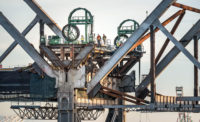
The San Francisco Bay Bridge will not open on time because of the ongoing effort to fix broken shear bolt rods. California lawmakers, meanwhile, vow to hold accountable those responsible for the delay to replace the seismically deficient current bridge.
Originally planned to open on Labor Day, the $6.3-billion bridge's new opening date has not been determined but likely will occur no earlier than Dec. 10. That's when contractor American Bridge/Fluor Joint Venture is expected to complete a retrofit to replace the clamping force of 96 A354-grade BD high-strength steel rods installed on the self-anchored suspension (SAS) bridge of the new east span. When tightened to their specified tension levels in March, 32 of the anchor rods failed due to hydrogen embrittlement.
"The need to delay the opening in order to fully repair busted bolts is just the latest frustration associated with this project," says state Sen. Mark DeSaulnier, chairman of the transportation committee. "The commuters are the ones who have paid for this project as it has skyrocketed over budget, and they are the ones left vulnerable each day that they must cross the old span. Those responsible for these delays must be held accountable."
A bridge oversight committee drawn from various state transportation entities released a comprehensive report on the 96 defective bolts, as well as analysis of 2,210 similar bolts located throughout the bridge's piers, towers, anchorages and saddles.
The report calls for replacement of 740 additional bolt rods after the bridge opens. Another 557 bolts will remain in place but at reduced tension, 274 more will undergo augmented dehumidification, and the remaining 639 will be monitored over time.
Multiple missteps led to the embrittlement of the rods, the report says. Engineer-of-record T.Y. Lin International/Moffatt & Nichol Design Joint Venture originally specified the high-strength steel rods to be mechanically galvanized. However, after a bidder inquiry pointed out the difficulty of using the procedure due to the weight and size of the rods, an addendum was issued allowing hot-dipped galvanizing, a high-heat method that can cause hydrogen to be released from the steel and become encapsulated in the zinc coating.
While engineers knew the risks of hot-dipping, Caltrans previously had used this method successfully on other bridges. However, the Bay Bridge rods would be under much higher tensioning. "There is little documented discussion regarding the variety of applications and far higher tension levels that would be placed on some of the high-strength rods on the SAS Bridge and potential alternative corrosion protection methods," the report says. The report also cites the engineer-of-record and Caltrans for using the same specs for rods in seven different locations on the SAS structure.
Other factors leading to rod failure included disparities in hardness and toughness and improper heat treatment, which led to a non-uniform metallurgical structure. Dyson Corp., Painesville, Ohio, was the manufacturer. Construction oversight technicians did not test the rods for hydrogen embrittlement, as required. "Closer coordination was needed between design and construction staff," the report says.
The report identifies the various responsible parties, but Randy Rentschler, president of the Metropolitan Transportation Committee, says it won't be the sole determinant in who will be held financially accountable for the delays and repairs. "There is no doubt there is going to be some action on that front," he adds.



Post a comment to this article
Report Abusive Comment